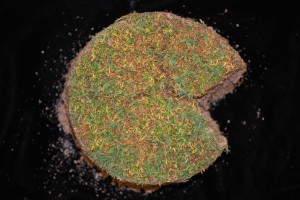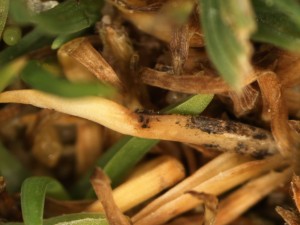Surprise, surprise! Our old friend anthracnose basal crown rot just came home to roost! An unexpected influx of putting green samples diagnosed with anthracnose were submitted to Rutgers Plant Diagnostic Lab this week.

Sample of a mixed bent grass and annual bluegrass putting green with anthracnose basal crown rot. Photo: Sabrina Tirpak, Rutgers PDL
Samples were submitted from golf courses in New Jersey, New York, and Ohio with thinning and yellowing annual bluegrass. A quick tug on the yellow plants revealed the presence of the fungus Colletotrichum cereale, which is the cause of anthracnose. I suspect that we are simply seeing overwintering crown infections at this time and not new disease outbreaks. If you remember, Memorial Day weekend brought us a couple “real” summer days with enough temperature and moisture stress to knock off some – otherwise seemingly healthy – plants that were carrying the anthracnose burden from last season over the winter.

A quick tug on a yellow plant reveals the presence of Colletotrichum cereale. Photo: Sabrina Tirpak, Rutgers PDL.
If this is your situation, there is no need to panic just yet. It is early in the season and if you have an unwanted visitor on your putting green, there is a clear path to minimize the disease. Nearly a decade of Rutgers turfgrass research on anthracnose has yielded a detailed set of best management practices for anthracnose that will help get your annual bluegrass putting greens through the rest of the season. Carefully follow the doctors’ advice and you won’t need a shoulder to cry on come mid-summer!

